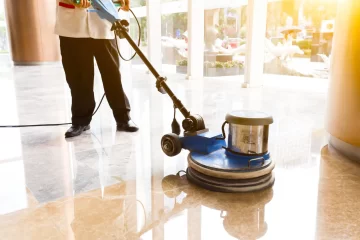
Why Marble Needs Professional Care
Marble floors are a luxurious feature in any home or commercial space, admired for their rich texture and timeless appeal. However, over time, foot traffic, dust, and spills can dull their shine and leave behind scratches or stains. If your floors have lost their brilliance, it’s time to restore the shine with professional marble polishing.
This blog will walk you through everything you need to know about the marble polishing process, why hiring professionals is the best option, and how it can dramatically improve the look and feel of your interiors.
What Is Marble Polishing?
Marble polishing is a restoration technique that revives the shine and smoothness of marble surfaces. It involves a series of steps using specialized tools, polishing powders, and diamond abrasives to remove surface imperfections and bring back a glossy, mirror-like finish.
Unlike regular cleaning, polishing addresses:
- Surface scratches
- Etch marks and stains
- Dullness from wear and tear
The result? A floor that looks brand new and is protected from future damage.
Why Professional Marble Polishing is the Smart Choice
1. Superior Shine
Professionals use industrial-grade machines and diamond pads that can achieve a higher level of shine than DIY methods. The result is a flawless, glossy finish that enhances your space instantly.
2. Surface Protection
During the polishing process, a protective sealant is often applied, helping to prevent stains and reduce wear in high-traffic areas.
3. Expertise in Stone Types
Different types of marble (Makrana, Italian, Indian, Carrara, etc.) require different approaches. Professionals assess the stone type and customize the polishing process accordingly.
4. Time and Cost Efficiency
DIY methods can lead to costly mistakes and uneven results. Hiring experts saves you time and ensures long-lasting quality.
Step-by-Step: The Professional Marble Polishing Process
Step 1: Inspection and Assessment
The marble polishing process begins with a detailed inspection of the marble. Technicians assess the level of wear, type of marble, and specific issues like stains or cracks.
Step 2: Deep Cleaning
Before polishing, the surface is cleaned with a pH-neutral marble cleaner to remove dust, oil, and grime.
Step 3: Grinding (Honing)
If the marble is heavily scratched or stained, technicians use diamond grinding pads to remove the top layer of stone, exposing a fresh surface.
Step 4: Polishing
Using fine abrasives and polishing powders, the surface is worked to bring out a smooth, glossy finish. This can be done using either a wet or dry polishing method, depending on the marble type and environment.
Step 5: Buffing and Sealing
After polishing, the floor is buffed for uniform shine. Then, a marble sealant is applied to protect the surface from stains and moisture.
Benefits of Professional Marble Polishing
- Restores original shine and color
- Improves slip resistance and safety
- Extends the life of your flooring
- Boosts property value and aesthetic appeal
- Makes daily cleaning easier
Whether you’re polishing your home’s hallway or an office lobby, professional services ensure durable and dazzling results.
Ideal Places for Marble Polishing
Professional marble polishing is perfect for:
- Homes (living rooms, foyers, kitchens)
- Hotels and resorts
- Office lobbies
- Showrooms
- Hospitals and clinics
- Religious spaces and monuments
How Often Should Marble Be Polished?
The frequency of marble polishing depends on usage:
| Environment | Recommended Frequency |
|---|---|
| Residential Homes | Every 12–18 months |
| High-Traffic Offices | Every 6–12 months |
| Hotels & Showrooms | Quarterly or Bi-annually |
Regular maintenance and sealing can extend the interval between polishing sessions.
DIY vs. Professional Marble Polishing
| Feature | DIY Method | Professional Service |
|---|---|---|
| Shine Quality | Low to Medium | High-gloss, uniform finish |
| Time Required | Long, multiple attempts | 1–2 days |
| Equipment Needed | Basic tools, consumer-grade pads | Industrial machines, diamond pads |
| Risk of Damage | High (etching, uneven polish) | Low (handled by experts) |
| Long-Term Durability | Short-lived | Lasting results with protection |
Common Questions About Marble Polishing
Q: Can all marble types be polished?
Yes. However, the polishing method may differ based on the stone’s porosity and hardness.
Q: Is polishing safe for old marble floors?
Absolutely. In fact, polishing can revitalize aged marble, making it look new again.
Q: How long does a typical polishing job take?
It depends on the size, but most residential jobs (under 500 sq. ft.) can be completed in 1–2 days.
Q: Will polishing remove all stains and scratches?
Light to moderate stains and surface scratches are usually removed. Deep stains may require extra grinding or spot treatment.



